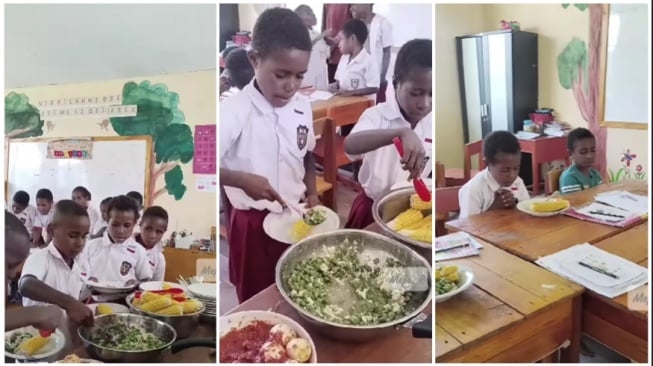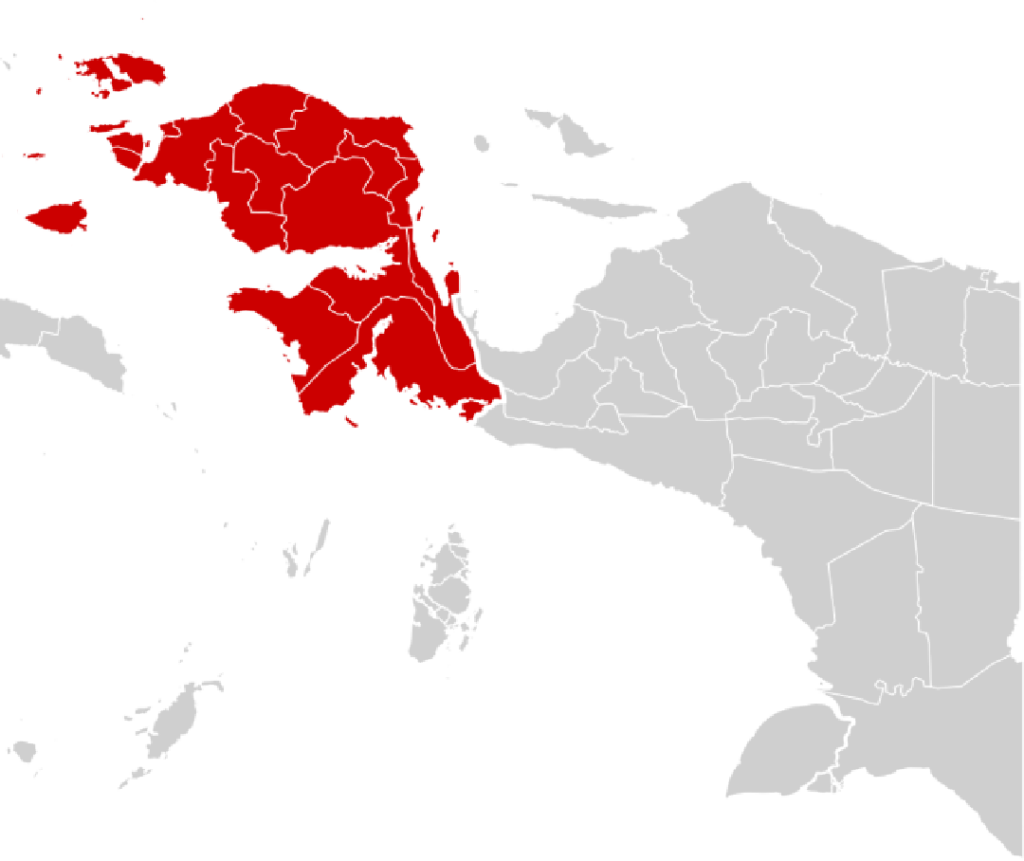In a quiet village nestled in the highlands of Papua, far from the spotlight of national politics and media attention, a group of children sat down to eat. The food was simple—steamed corn, stir-fried green beans with eggs, a boiled egg, and homemade tomato sambal. Yet what happened that day did not go unnoticed. A video capturing this humble moment, filmed by a teacher and uploaded to social media, quickly spread across Indonesia’s digital landscape, sparking waves of admiration, emotional responses, and unexpected comparisons. The reason? It was not just a meal—it was a message.
The children, wearing red-and-white school uniforms, had just returned from a one-week school closure due to a scabies outbreak. Their teacher, visibly moved, had organized the meal as a celebration of recovery, community, and togetherness. What made it all the more powerful was how the meal had come together: not through government funding or institutional programs, but through the voluntary efforts of local residents, parents, teachers, and small-time donors. The corn had been bought from local mothers, the green beans donated by villagers, the eggs gifted by kindhearted supporters, and the tomatoes harvested from the teacher’s own garden. This was, in every sense, a meal born from community.
And across Indonesia, netizens noticed.
A Viral Video with a Deeper Message
The video, short and unassuming, opens with children lining up in an orderly fashion. They are polite, quiet, and clearly hungry. Their teacher scoops food onto their plates with care, while the children wait patiently for their turn. Before eating, the group bows their heads in prayer—a pause that adds even more weight to what is about to happen. Then, they eat.
There is no drama, no grand production. Just children enjoying a nutritious meal, surrounded by love and support. But as the video gained traction online, it became evident that this was not just about the food—it was about what the food represented: dignity, community resilience, and a real-life example of how health and nutrition programs could be done right, especially in remote areas like Papua.
For many viewers, especially in light of ongoing controversies surrounding the national “Makan Bergizi Gratis” (MBG), or Free Nutritious Meal program, the contrast was striking. While MBG had faced criticism for its implementation, lack of local input, and even occasional health concerns, here was a grassroots initiative that appeared to do everything right—no bureaucracy, no procurement scandals, just a meal rooted in care and common sense.
Netizens React: “This Is What Real Nutrition Looks Like”
The reaction on social media was swift and overwhelmingly positive. Thousands of netizens took to platforms like Instagram, X (formerly Twitter), and TikTok to praise the effort, many sharing the video with heartfelt captions and comments. Some highlighted how fresh and healthy the food looked, while others applauded the teacher’s dedication and the community’s spirit of cooperation.
“This is what real nutrition looks like,” one user wrote. “No frozen food, no preservatives, just local produce and love.”
Another post read, “Papua always teaches us how to live with dignity. The children’s smiles, the teacher’s care, the simplicity—it’s beautiful.”
Many users didn’t shy away from drawing comparisons. Comments such as “Better than the MBG meals in my city” and “The government should learn from this” became common refrains. Some even argued that this video served as a quiet but powerful critique of the national program, which has often been rolled out in a top-down fashion, without considering local food cultures or logistical challenges unique to each region.
Yet, amid the praise, there were also thoughtful reflections. Netizens acknowledged that while this grassroots model was inspiring, it might not be scalable without structural support. Still, the consensus was clear: this was a moment worth celebrating—and replicating where possible.
Behind the Scenes: How One Village Made It Happen
While netizens praised the video, few may have fully understood just how significant this moment was for the community involved. In the village where this took place, food insecurity and health issues are not abstract problems—they are part of daily life. The recent scabies outbreak had disrupted not just learning but the entire rhythm of community life. School closures in remote areas like this don’t just delay education; they often interrupt the only structured part of many children’s lives.
So when the school reopened, it was about more than just returning to class. It was about healing, reconnection, and reminding the children—and the village—that they were not forgotten.
The decision to prepare a healthy meal wasn’t made lightly. The teacher behind the initiative, whose name was not mentioned in the video but whose compassion spoke volumes, rallied the community. Mothers brought corn from their home gardens. Villagers who had green beans to spare came forward. A few supporters, perhaps living in more urban areas but still connected to the village, donated eggs. The teacher’s own tomato plants, grown on school grounds, provided the final touch: a bright red sambal that brought flavor to the plate.
Everything about the meal reflected thoughtful, culturally resonant nutrition. These were foods the children knew, foods they could digest well, and foods that reflected their land and way of life. And perhaps that’s what moved people the most—this wasn’t charity. This was sovereignty. Food sovereignty, educational care, and communal love—all on one plate.
The MBG Debate: A Silent Comparison
It is impossible to separate the timing of this video from the broader national conversation around MBG. The Free Nutritious Meals program, a flagship policy initiative aimed at tackling child malnutrition and improving school attendance, has faced several hurdles. While its intention is noble—providing millions of Indonesian children with daily nutritious meals—its rollout has been uneven.
Reports of questionable food quality, poor sanitation, logistical issues, and even student poisoning in some areas have marred public perception. Critics argue that the program, though well-intended, suffers from a lack of localization—meals are often prepared with little understanding of regional dietary habits or available ingredients.
In this context, the video from Papua struck a nerve. Here was a small, rural school providing exactly the kind of nutrition MBG promised, without any government intervention. No central menus, no outside contractors—just community-driven action. The message was clear: perhaps the answers are closer than we think. Perhaps the people most capable of solving local problems are the locals themselves.
Of course, many were quick to point out that this shouldn’t absolve the state of its responsibilities. Nutrition is a right, not a privilege or a product of luck. But the Papuan example did illuminate an important point: success lies in partnership, not prescription.
Why This Matters: A Story of Resilience and Vision
What makes this story resonate so deeply isn’t just the meal—it’s what the meal represents. In a world increasingly dominated by centralized systems, algorithms, and supply chains, here was a moment that reminded people of something more organic: that community still matters, that people can come together to nourish each other, and that the human touch is still powerful.
For the children, the meal likely meant more than just full stomachs. It was a signal that they were seen and cared for, that they mattered. For the teacher, it was an act of devotion, of showing that even in scarcity, we can create abundance. For the villagers, it was an affirmation of their place in the educational ecosystem. And for the nation watching, it was a lesson.
A lesson that nutrition doesn’t have to come in the form of prepackaged food or top-down mandates. That sometimes, the best solutions are the most rooted ones. That food, in its simplest form, can carry stories of resilience, belonging, and hope.
Moving Forward: Lessons from a Village
So, what can Indonesia—and the world—learn from this viral moment?
First, community ownership is powerful. When locals are empowered to participate in shaping school nutrition, outcomes improve—not just in health, but also in education, economy, and dignity.
Second, that local ingredients and food cultures matter. Nutrition programs must adapt to geography, climate, agriculture, and tradition. What works in Jakarta may not work in Jayapura, and that’s not a failure—it’s a fact to be embraced.
Third, that digital storytelling can be transformative. This meal could have gone unnoticed, but a simple video turned it into a national conversation. There’s power in telling stories—not just of problems, but of solutions.
And finally, that care scales when supported properly. The Papuan model doesn’t have to be isolated. With the right policies, funding, and training, this kind of grassroots effort can become part of a national strategy—one that listens to communities rather than speaks over them.
Conclusion
In the end, the Papuan school lunch was more than a viral moment. It was a microcosm of what is possible when people come together with a shared goal. It reminded a nation of what real nutrition looks like—not just calories on a plate, but connection, culture, and compassion.
In that small, sunlit schoolyard, with a plate of corn and green beans, the children of Papua didn’t just eat. They made us believe—if only for a moment—that a better, fairer, healthier Indonesia is within reach.
One meal at a time.


